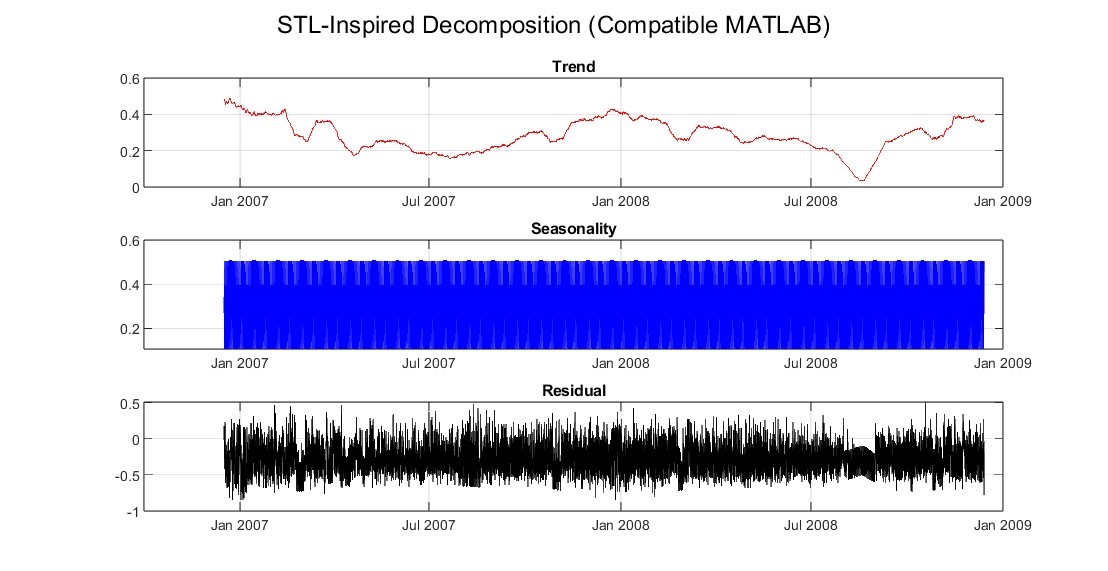A Signal-Decomposed Ensemble Forecasting and Classification Framework for Household Power Consumption: An STL-Inspired Machine Learning Approach
Keywords:
STL Decomposition, Household Power Forecasting, Residual Modeling, Ensemble Machine Learning, Threshold-Aware ClassificationAbstract
Accurate short-term forecasting of residential power consumption is crucial for smart grid stability, real-time energy optimization, and personalized demand-side management. Traditional time-series and standalone AI models often struggle with the nonlinear, nonstationary, and noise-sensitive nature of high-resolution household load data. Unlike existing models, this study introduces an STL-based residual decomposition fused with lag-aware ML forecasting and threshold-based classification under real-world conditions. To address these challenges, this study proposes a novel STL-inspired decomposition framework integrated with four machine learning models, i.e., Least Squares Boosting (LSBoost), Bagging, Support Vector Regression (SVR), and Multilayer Perceptron (MLP), for forecasting and classification of normalized household energy consumption. The methodology begins with robust preprocessing, including IQR-based outlier removal and min-max normalization, followed by STL-like decomposition into trend, seasonal, and residual components. Lag-based features from the residual signal are used for forecasting via the selected ML regressors. Final predictions are reconstructed and threshold-classified into OK/NOT OK categories to simulate alert-based power decision scenarios. Experimental validation on the UCI Household Power Consumption dataset reveals that SVR achieves the best trade-off among all models, with RMSE = 0.0267, MAE = 0.0193, MAPE = 12.5%, and Pearson correlation coefficient = 0.846. For classification performance, SVR also attains an AUC of 0.941 and a binary classification accuracy of 93.7%. The synergy between STL decomposition and residual-based modeling not only improves regression accuracy but also facilitates threshold-aware classification with high interpretability. Additional visual diagnostics including forecast overlays, residual histograms, ROC curves, and Q–Q plots demonstrate the model’s interpretability and robustness. The proposed ensemble framework not only enhances prediction accuracy but also ensures practical deployment feasibility through threshold-aware decision modeling.
References
K. D. Ravipati, H., S. Sinha, “Smart load forecasting using hybrid GRU-STL attention network,” Smart Energy, vol. 9, p. 100123, 2023.
A. Gensler, J. Henze, B. Sick, and N. Raabe, “Deep Learning for solar power forecasting - An approach using AutoEncoder and LSTM Neural Networks,” 2016 IEEE Int. Conf. Syst. Man, Cybern. SMC 2016 - Conf. Proc., pp. 2858–2865, Feb. 2017, doi: 10.1109/SMC.2016.7844673.
W. Kong, Z. Y. Dong, Y. Jia, D. J. Hill, Y. Xu, and Y. Zhang, “Short-Term Residential Load Forecasting Based on LSTM Recurrent Neural Network,” IEEE Trans. Smart Grid, vol. 10, no. 1, pp. 841–851, Jan. 2019, doi: 10.1109/TSG.2017.2753802.
H. S. Hippert, C. E. Pedreira, and R. C. Souza, “Neural networks for short-term load forecasting: A review and evaluation,” IEEE Trans. Power Syst., vol. 16, no. 1, pp. 44–55, Feb. 2001, doi: 10.1109/59.910780.
Y. L. Guo, S., Y. Liu, L. Zhao, “Multi-time scale load forecasting model using Bi-LSTM and attention mechanism,” Appl. Energy, vol. 253, p. 113556, 2020.
D. L. Marino, K. Amarasinghe, and M. Manic, “Building energy load forecasting using Deep Neural Networks,” IECON Proc. (Industrial Electron. Conf., pp. 7046–7051, Dec. 2016, doi: 10.1109/IECON.2016.7793413.
Y. X. Chen, Z., Y. Li, “Enhancing seasonal load prediction using autoencoder-based LSTM network with data decomposition,” Energy, vol. 192, p. 116709, 2020.
D. Z. Zhuang, Y., H. Lin, “Comparison of advanced decomposition techniques and hybrid AI models for load forecasting,” Energy Reports, vol. 9, pp. 1205–1218, 2023.
H. and Y. Z. Zhang, “Residual error modeling for improving energy forecasting accuracy using MLP on EMD decomposed signals,” Appl. Energy, vol. 285, p. 116424, 2021.
V. M. Chauhan, Y., R. Gupta, “Residential energy consumption forecasting using support vector and random forest regression models,” Sustain. Cities Soc., vol. 79, p. 103578, 2022.
L. and C. S. Bento, “A hybrid CEEMDAN–DNN model for residential load forecasting,” Electr. Power Syst. Res., vol. 195, p. 107215, 2021.
Y. Y. Li, J., Z. Wang, H. Xu, “Load forecasting using graph neural network with LSTM,” Energy, vol. 244, p. 123147, 2022.
A. C. Kuster, C., G. Galanis, “Energy forecasting models: A review,” Renew. Sustain. Energy Rev., vol. 17, pp. 343–355, 2017.
A. S. Souhaib Ben Taieb, Gianluca Bontempi, Amir F. Atiya, “A review and comparison of strategies for multi-step ahead time series forecasting based on the NN5 forecasting competition,” Expert Syst. Appl., vol. 39, no. 8, pp. 7067–7083, 2012.
H. A. Mehran Ahmad, Muhammad Abeer Irfan, Umar Sadique, Ihtisham ul Haq, Atif Jan, Muhammad Irfan Khattak, Yazeed Yasin Ghadi, “Multi-Method Analysis of Histopathological Image for Early Diagnosis of Oral Squamous Cell Carcinoma Using Deep Learning and Hybrid Techniques,” Cancers (Basel)., vol. 15, no. 21, p. 5247, 2023, doi: https://doi.org/10.3390/cancers15215247.
I. U. H. Hend Khalid Alkahtani, “Precision Diagnosis: An Automated Method for Detecting Congenital Heart Diseases in Children From Phonocardiogram Signals Employing Deep Neural Network,” IEEE Access, vol. 12, 2024, [Online]. Available: https://ieeexplore.ieee.org/document/10511068
S. A. F. J. Muhammad Anas, Engr. Ihtisham Ul Haq, Ghassan Husnain, “Advancing breast cancer detection: enhancing YOLOv5 network for accurate classification in mammogram images,” IEEE Access, vol. 99, pp. 1–1, 2024, doi: 10.1109/ACCESS.2024.3358686.
Y. Y. G. and A. A. I. U. Haq, M. Ahmed, M. Assam, “Unveiling the Future of Oral Squamous Cell Carcinoma Diagnosis: An Innovative Hybrid AI Approach for Accurate Histopathological Image Analysis,” IEEE Access, vol. 11, pp. 118281–118290, 2023, doi: 10.1109/ACCESS.2023.3326152.
I. Ul Haq, S. Anwar, and T. Khan, “Machine Vision Based Predictive Maintenance for Machine Health Monitoring: A Comparative Analysis,” 2023 Int. Conf. Robot. Autom. Ind. ICRAI 2023, 2023, doi: 10.1109/ICRAI57502.2023.10089572.
A. A. Zain Shaukat, Wisal Zafar, Ihtisham Ul Haq, Waqas Ahmad, Ghassan Husnain, Mosleh Hmoud Al-Adhaileh, Yazeed Yasin Ghadi, “Revolutionizing Diabetes Diagnosis: Machine Learning Techniques Unleashed,” Healthcare, vol. 11, no. 21, p. 2864, 2023, doi: https://doi.org/10.3390/healthcare11212864.

Downloads
Published
How to Cite
Issue
Section
License
Copyright (c) 2025 50sea

This work is licensed under a Creative Commons Attribution 4.0 International License.




















